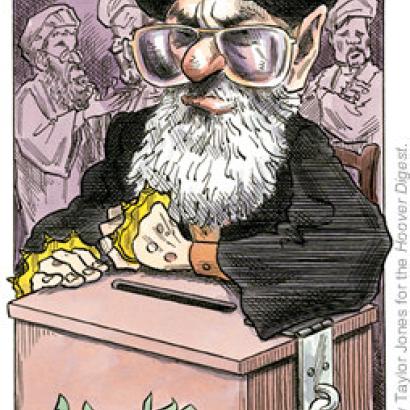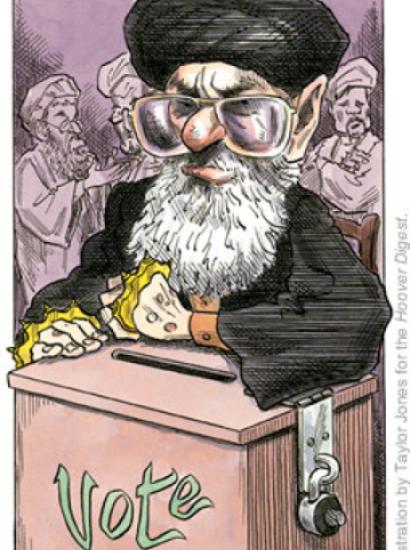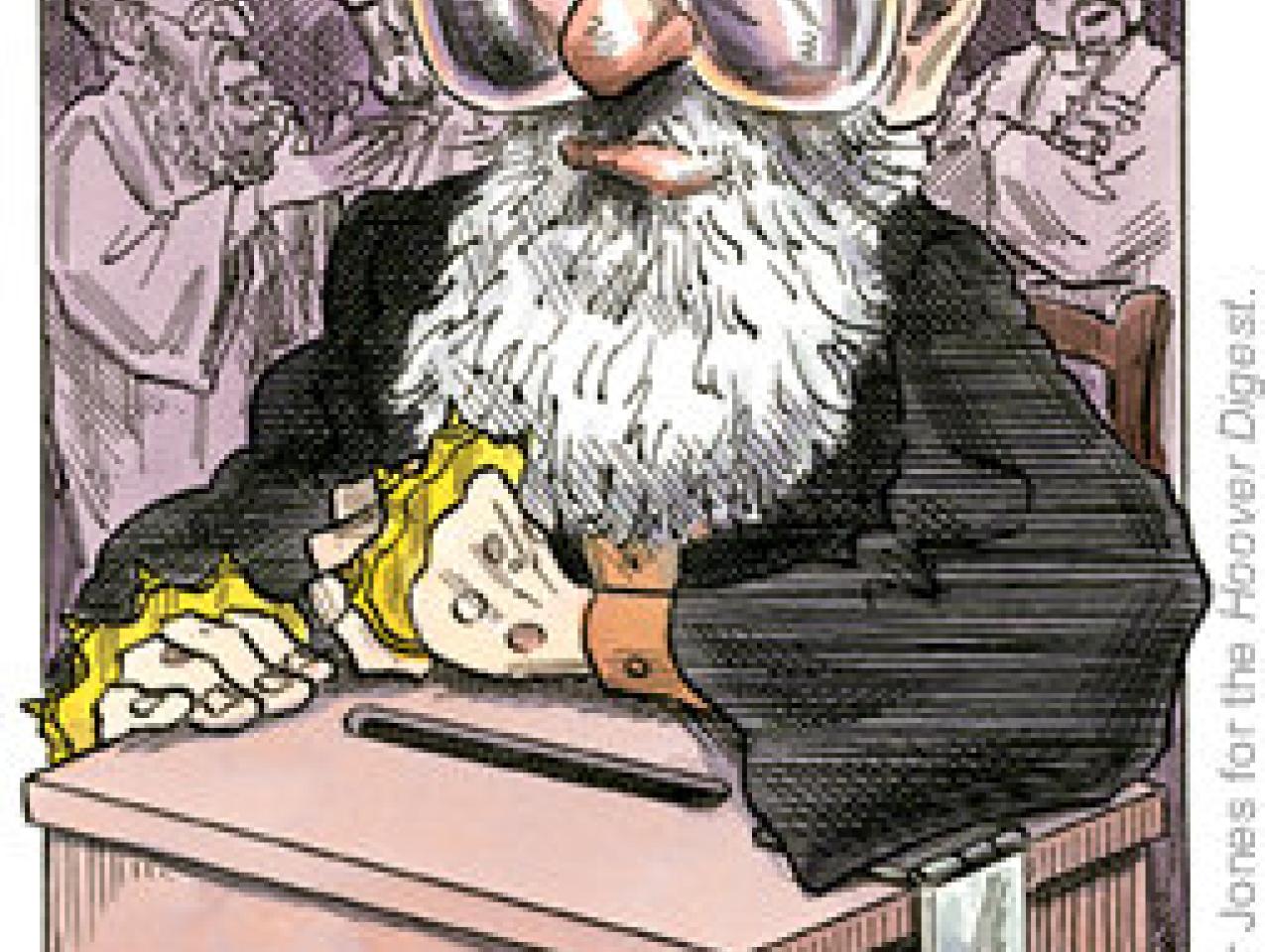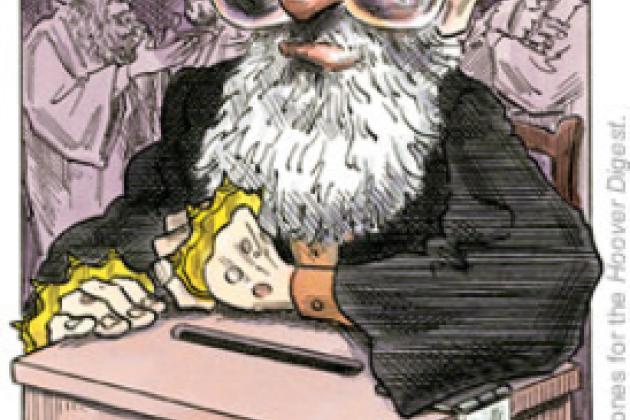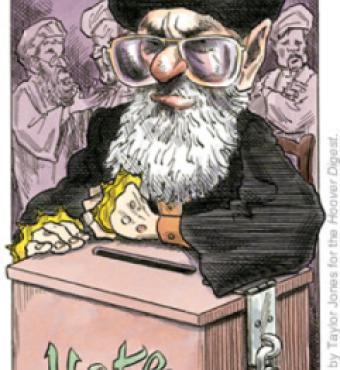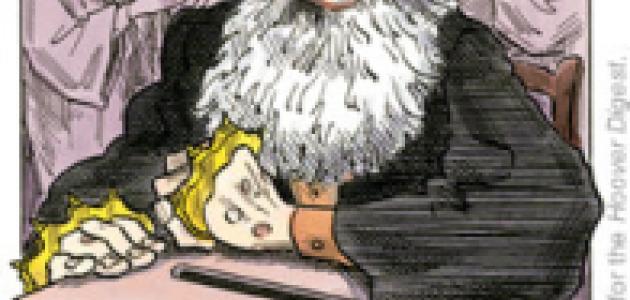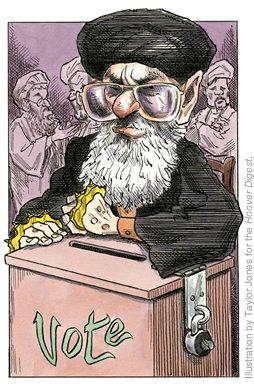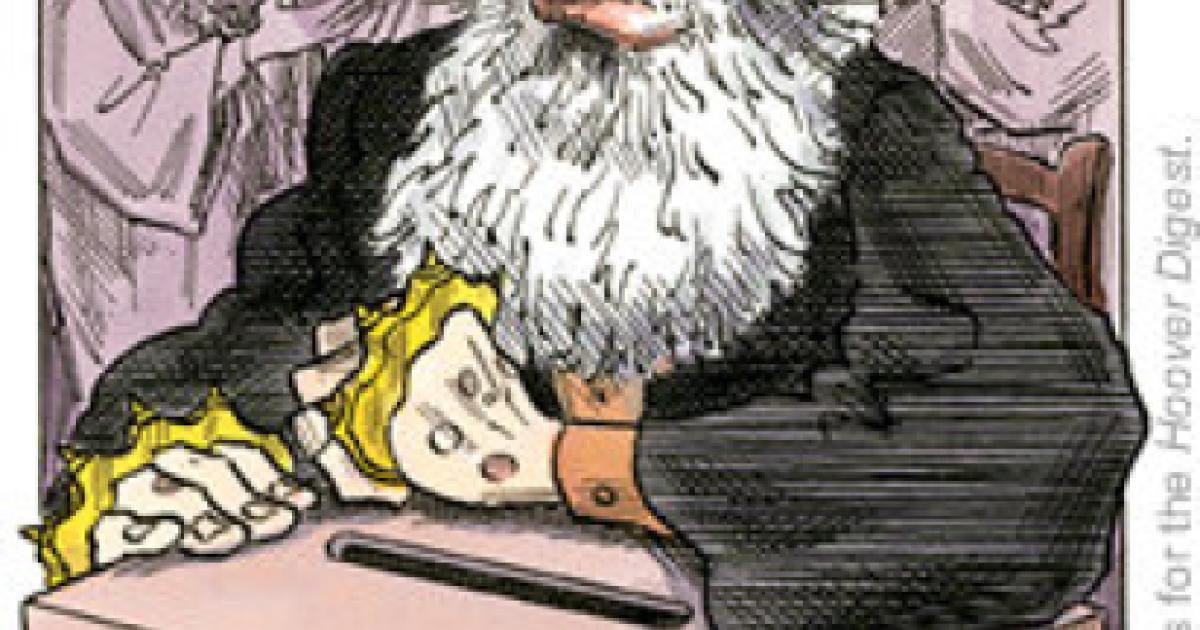- International Affairs
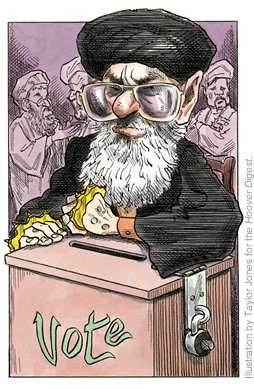
In his State of the Union speech in January, President Bush affirmed his belief that “God has planted in every human heart the desire to live in freedom” and that therefore “America is pursuing a forward strategy of freedom in the greater Middle East. We will challenge the enemies of reform, confront the allies of terror, and expect a higher standard from our friends.”
President Bush has devoted many such words in support of promoting democracy in the greater Middle East. However, many in the region—advocates and enemies of reform alike—still doubt the president’s real commitment to the mission of spreading democracy. Instead, they see in Washington an administration focused more on the immediate goals of arresting terrorists and eliminating weapons of mass destruction. Success in achieving these short-term goals requires cooperation with dictators such as Musharraf in Pakistan and Qaddafi in Libya. Although Qaddafi’s diplomacy received words of praise in Bush’s State of the Union address, there was no acknowledgment of the Libyan democrats who have survived long years of despotism. These mixed signals send the wrong message to those on the frontlines fighting for democracy in the region.
Nowhere does this mushy message do more damage than in Iran. If President Bush is serious about promoting democracy in the greater Middle East, then a strategy to assist democratization in Iran should be a top priority. No country in the region, after all, is riper for a democratic breakthrough. At the same time, especially after the farcical parliamentary election in February, Iranian democrats have entered a dark and difficult phase in the development of their struggle. Now more than ever they need clarity about American intentions and real demonstrations of commitment to the cause of Iranian democracy from their American counterparts.
An Electoral Coup
Iran’s parliamentary election, held on February 20, turned out to be a farce. It was, in effect, an electoral coup. Conservative clerics used their self-declared right to vet candidates to the parliament to eliminate more than 2,000 reformist candidates from running in the election. In at least 190 districts—easily more than half all the seats in the parliament—they “approved” only conservative candidates, thus ensuring for themselves a clear majority in the parliament.
Prior to the election, the political system had been in near-paralysis. The ruling elite was divided into a reformist faction and a conservative faction, with neither group being sufficiently strong to fully prevail over the other. At the same time there was a burgeoning movement for democratic reform at the grassroots level that included students, technocrats, journalists, disgruntled members of the middle class, and women (who have remained in the forefront of the democratic struggle for 25 years).
As medieval Islam divided the world between dar-al Islam and dar-al-kofr, or the “house of Islam” and the “house of infidels,” the Iranian regime too divides the citizens of the country between Khodis and Gayr-eKhodis, or the “insiders” and the “outsiders.” Power rested in the hands of the insiders—while for the outsiders, there was disenfranchisement at best and exile, banishment, and death at worse. Yet prior to the election, there was some cause for hope. The reform faction, led by President Mohammad Khatami, had attempted to extend some of the freedoms enjoyed by the insiders to the outsiders. Meanwhile, the democratic movement at the grass roots made Iran the most viable candidate of the Muslim countries to break out of a millennium-old mold of despotism.
The election in February was a major step backward. The reformers suffered a severe setback. Ayatollah Khamenei—Khomenei’s successor as the real leader of Iran—handpicked members of the new parliament through the conservative-dominated Guardian Council, which has the authority to vet candidates. Furthermore, his handpicked members of the Guardian Council and parliament are likely to soon welcome his handpicked president; and then even the pretense of a republic will wither as the reality of the one-man rule becomes more apparent.
In discussing the election (dubbed the “Friday coup” for the day on which it was held), analysts have focused rightly on how the reformists were pushed aside in the electoral putsch. But the reality was more complicated. The most disenfranchised were of course the Iranian people, who were denied the chance to participate in fair and free elections. They showed their disgruntlement by their refusal to participate in the badly compromised process. Only 50 percent of eligible voters went to the polls, showing a drop of about 15 percent since the last national elections. Furthermore, pernicious but pervasive rumors about punishments meted out to those who did not vote—it was rumored, for instance, that a failure to vote could prevent one from getting admitted to a university—forced many of these outsiders to go to the voting polls. Even then, no more than 30 percent of Tehran’s eligible voters went to the polls.
Of the insiders, two other hitherto powerful factions were also victims, along with the reformists, in this electoral coup. Hashemi Rafsanjani, once reputed to be Iran’s real “strongman,” seems now to be altogether marginalized. Nearly all his cohorts and allies have been eliminated from the parliament, while relatives of Rafsanjani, including his brother who used to serve as the undersecretary for the oil ministry, have recently “retired.”
The other group conspicuously absent from the newly elected parliament are members of the group called Mo’talefe, hitherto one of the pillars of Khamenei’s power and the bastion of conservative fundamentalism. Mo’talefe—originally a covert terrorist group established in the early 1960s to fight the Shah, which has turned into an ostensibly overt “political” party only in recent months—had also been the conduit between the traditional bazaar and the top brass of the clergy. In other words, the February election was not only a big setback for the reformers and the people of Iran but also a major blow to conservative factions within the regime. Power has now been consolidated around one man—Ayatollah Khamenei.
The Hard-liners Take Control
What then is the reason for this coup, and what does it mean for the future of democracy in Iran and the region? The attempt to consolidate power in the hands of one man is less a sign of systemic power than a sign of weakness. The regime knows that it is entering a perilous period and that its very survival is on the line. Concentrated leadership, it thinks, will help it navigate the increasingly inhospitable waters. Rid of the rigid cultural politics of the conservatives, on the one hand, and of the political embarrassments brought about by widespread rumors of financial corruption by Rafsanjani and members of his family, on the other, Khamenei hopes to have a better chance of solving the crisis. If the International Atomic Energy Agency produces another damning report of lies and deceptions in the regime’s nuclear program, it will be more difficult for the regime’s European allies to continue their engagement with this autocratic regime. Recent comments by the European Union’s spokesperson criticizing the recent elections are early hints of a possible rift with Europe. The regime’s internal isolation will be complemented by its international isolation when Europe decides to align itself with Iran’s democratic movement rather than its despotic rulers.
The sine qua non of this movement has been the principle that democracy and the rule of an all-powerful “spiritual leader” (the position held by Khamenei) are simply incompatible. Hitherto many of the reformists harbored illusions about this fact. In the now memorable phrase of Said Hajjariyan, one of the leaders of the reform movement, their formula for change was simple: “pressure from below, haggle at the top.” In other words, they hoped to use the pressure for democratic change brought to bear by students, journalists, women, and members of the middle and working classes to get a bigger piece of the political pie for their group of insiders and lessen the chance of a popular eruption. What they have now realized is that the mullahs at the top do not play by any rules, save those that serve their interests. Dismayed and disappointed by how little their “haggling” accomplished, they now have an opportunity of joining the democratic forces.
With these reformists—who are an important segment of Iranian society—now finally ready to cut the cord from the Islamic regime, they can join the ranks of the democratic movement, making it both more representative and more powerful. For several years, the reformers had one foot in the regime and one foot in society. Now they have been pushed out of the regime and must stand firmly with democratic forces in society.
In this new polarized context, the regime’s only hope, and arguably its ultimate plan, is to make peace with the United States, and rely on that peace to improve the country’s dire economic conditions. The regime hopes to follow the “China model,” mixing economic recovery with an authoritarian political system. President Bush’s recent criticisms of the February elections are a hopeful sign that the administration will not fall prey to the temptation of making a deal—around the nuclear issue and Iraq—with the masterminds of the coup.
The Polish Model
For most Americans, Iran is viewed as a totalitarian regime, not unlike other dictatorships in the region and not that different from the other remaining member of the axis of evil, North Korea. In reality, Iranian society is one of the most pluralist—and its Islamic rule the most tenuous—in the region, and the prospects for a democratic breakthrough are greater there than anywhere else in the autocratic Muslim world.
Iran occupies the same place in its neighborhood as Poland did in communist Europe in the 1980s. Like Poland two decades ago, Iranian society is organized, hostile to the regime, pro-democratic, and pro-American, while Iranian rulers—like their Polish counterparts 20 years ago—have no legitimacy, believe in nothing, are deeply corrupt, and seem ready to use any means necessary to survive. Also like Poland after the crackdown on Solidarity in December 1981, the democratic movement in Iran has tasted the rewards of mobilization and come close to seizing power (after the 1997 presidential election) but then experienced disappointment and disillusionment. Solidarity, it should be remembered, also seemed to be going nowhere in the mid-1980s. When the roundtable process in 1989 suddenly launched a series of unintended, positive consequences, Poland’s democratic revolution helped to spark democratic change throughout the region.
During the dark years in Poland in the mid-1980s, external forces helped keep hope alive. The West had a strategy for promoting regime change in Poland, which included big actors such as the Catholic Church and the AFL-CIO, as well as smaller forms of assistance such as educational exchanges, small business joint ventures, and relatively free travel between Warsaw and Chicago. Polish society in the 1980s was not isolated from the West but connected to and supported by societal allies in the West. Equally important, the Polish people had no doubt whose side the American president was on. Ronald Reagan did not court the Polish general Jaruzelski in the name of stability. He provided moral and practical support to Polish democratic leaders in the name of change.
The American Role
President Bush should pursue a similar strategy toward the people of Iran today. The current political crisis underscores yet again the unique opportunity in Iran for democratic regime change. And if democracy succeeds in Iran, the positive reverberations around the region, including in Iraq and Afghanistan, will be enormous.
The first and most important step in executing a new strategy for promoting democracy in Iran is to clarify the United States’ position vis-à-vis the current Iranian regime. The recent elections—and the loss of any semblance of a democracy within the power structure—make this task easier now than in the past.
President Bush issued a bold statement of solidarity with the Iranian people a few days after the electoral coup. The administration must make clear that the United States has no intention of pursuing closer ties with Khamenei and his minions as a reward for dismantling their nuclear weapons program or for their promise of “cooperation” in keeping Iraqi Shiites calm.
The Bush administration cannot be tempted into entering into negotiations with Khamenei or his surrogates. Bush and his administration must initiate a more sophisticated and comprehensive strategy for engaging Iranian society. Most immediately, democratic forces in Iran need moral support from their friends in the West. They want to be reassured that the international community of democracies, including the United States, is still on their side. As a simple gesture of solidarity, President Bush should deliver a major speech devoted to Iranian democracy.
Over the long run, Iran’s democratic movement would benefit from greater contact with Western societies, more exposure to Western ideas, and more integration with Western economies. The same strategy and organizations that helped to engage Polish society (well, save the Catholic Church) must be deployed in Iran.
The future of Iran, and its long-cherished hope of democracy, must and will be determined inside Iran. But the United States can play a crucial role by siding with the democratic aspirations of the Iranian people. At this crucial turning moment in the struggle for democracy in Iran, President Bush must make it clear that democracy, not arms control, is the paramount American foreign policy goal with respect to Iran. Arms control negotiations with the conservative mullahs may serve American short-term interests but at the expense of more lasting gains. Solidarity ultimately did more to end the Cold War than SALT I or any other Soviet-American arms control agreement. After all, if Iran becomes a liberal democracy, then the Iranian nuclear threat to the United States will disappear.








